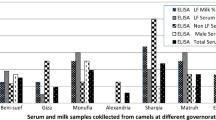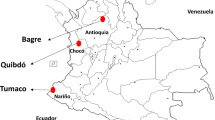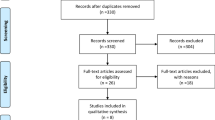Abstract
The present study aimed to use the loop-mediated isothermal amplification (LAMP) technique in comparison with serological tests to determine the rate of T. gondii infection in women suffering from spontaneous abortion (SA). A total of 140 women suffering from their first SA were included in this study. The collected aborted fetal remains and blood samples from each patient were examined in sterilized conditions using the LAMP technique and ELISA. Of the 140 women, 80 (57.1%) tested seropositive for anti-Toxoplasma antibodies by ELISA, 72 (51.4%) women tested seropositive for the IgG antibody, 8 (5.7%) tested seropositive for the IgM antibody. Among the eight women who’d had their first SA who tested seropositive for IgM antibody by ELISA, only five cases (62.5%) reported positively to the LAMP test. The difference in the frequency distribution of the LAMP results for measuring the Toxoplasma infection in pregnant women under study was statistically significant (P < 0.001) from the results of the serological test (ELISA). Although there was a significant difference between age and positivity in the LAMP test (P = 0.017), no significant difference was observed between positivity in the LAMP test and other variables. The findings of the present investigation suggest that LAMP is a preferred method for determining Toxoplasma infection in pregnant women suffering from SA compared with other routine serological tests. Even in a field with limited facilities and equipment, this technique can be effective and efficient in accurately and specifically diagnosing Toxoplasma infections in women at high risk of SA.


Similar content being viewed by others
References
Abd AA, Aal El, Nahnoush RK, Elmallawany MA et al (2018) Isothermal PCR for feasible molecular diagnosis of primary toxoplasmosis in women recently experienced spontaneous abortion. Macedonian J Med Sci 6:982–987
Abdoli AA, Soltanghoraee H, Ghaffarifar F (2017) Molecular detection and genotypic characterization of Toxoplasma gondiiin paraffin-embedded fetoplacental tissues of women with recurrent spontaneous abortion. Int J Fertil Steril 10:327–336
Arab-Mazar Z, Fallahi Sh, Koochaki A et al (2016a) Cloning, expression and immunoreactivity of recombinant Toxoplasma gondii GRA5 protein. Iranian J Microbiol 8:331–337
Arab-Mazar Z, Fallahi Sh, Koochaki A et al (2016b) Immunodiagnosis and molecular validation of Toxoplasma gondii-recombinant dense granular (GRA) 7 protein for the detection of toxoplasmosis in patients with cancer. Microbiol Res 183:53–59
Asgari Q, Fekri M, Monabati A et al (2013) Molecular genotyping of Toxoplasma gondii in human spontaneous aborted fetuses in Shiraz, Southern Iran. Iran J Public Health 42:620–625
Badparva E, Fallahi Sh, Sepahvand A et al (2009) The comparison of the efficacy of various fixatives on diverse staining methods of Giardia lamblia cyst. Pakistan J Biol Sci 12:1212–1216
Dunn D, Wallon M, Peyron F et al (1999) Mother-to-child transmission of toxoplasmosis: risk estimates for clinical counseling. Lancet 353:1829–1833
Elamin Elhag K, Elturabi SEM (2015) Seroprevalence of toxoplasmosis among women with abortion in Khartoum State. J Coastal Life Med 3:551–554
Fallahi Sh, Seyyed Tabaei SJ, Pournia Y et al (2014a) Comparison of loop-mediated isothermal amplification (LAMP) and nested-PCR assay targeting the RE and B1 gene for detection of Toxoplasma gondii in blood samples of children with leukaemia. Diag Microbiol Infect Dis 79:347–354
Fallahi Sh, Kazemi B, Seyyed Tabaei SJ et al (2014b) Comparison of the RE and B1 gene for detection of Toxoplasma gondii infection in children with cancer. Parasitol Int 63:37–41
Fallahi Sh, Arab Mazar Z, Ghasemian M et al (2015) Challenging loop-mediated isothermal amplification (LAMP) technique for molecular detection of Toxoplasma gondii. Asian Pacific J Trop Med 8:366–372
Fallahi Sh, Rostami A, Mohammadi M et al (2016) Practical parasitology courses and infection with intestinal parasites in students. J Infect Pub Health 9:654–660
Fallahi Sh, Rostami A, Birjandi M et al (2017) Parkinson's disease and Toxoplasma gondii infection: sero-molecular assess the possible link among patients. Acta Trop 173:97–101
Fallahi S, Rostami A, Nourollahpour Shiadeh M et al (2018) An updated literature review on maternal-fetal and reproductive disorders of Toxoplasma gondii infection. J Gynecol Obstet Hum Reprod 47:133–140
Ford HB, Schust DJ (2009) Recurrent pregnancy loss: etiology, diagnosis, and therapy. Rev Obstet Gynecol 2:76–83
Gilbert RE (2000) Epidemiology of infection in pregnant women. In: Petersen E, Amboise-Thomas P (eds) Congenital toxoplasmosis: scientific background, clinical management, and control, vol 5. Springer-Verlag, Paris, pp 237–249
Hanifehpour H, Samsam Shariat SK, Ghafari MS et al (2019) Serological and molecular diagnosis of Toxoplasma gondii infections in thalassemia patients. Iranian J Parasitol 14:20–28
Jahromi AS (2007) Anti-Toxoplasma antibodies in women with abortion or still birth. J Jahrom Univ Med Sci 4:47–52
Kheirandish F, Nazari H, Mahmoudvand H et al (2016) Possible link between Toxoplasma gondii infection and mood disorders in Lorestan province, Western Iran. Arch Clin Infect Dis 11:e36602 (8p)
Lau YL, Meganathan P, Sonaimuthu P et al (2010) Specific, sensitive, and rapid diagnosis of active toxoplasmosis by a loop-mediated isothermal amplification method using blood samples from patients. J Clin Microbiol 48:3698–3702
Mahmoudvand H, Fallahi Sh, Mahmoudvand H et al (2016) Efficacy of Myrtus communis L. to inactivate the Hydatid Cyst Protoscoleces. J Investigat Surg 29:137–143
Matin S, Shahbazi G, Tabrizian Namin S et al (2017) Comparison of placenta PCR and maternal serology of aborted women for detection of Toxopasma gondii in Ardabil, Iran Korean. J Parasitol 55:607–611
Menati Rashno M, Fallahi Sh, Kheirandish F et al (2016) Seroprevalence of Toxoplasma gondii infection in patients with Alzheimer’s disease. Arch Clin Infect Dis 11:e60133
Mousavi P, Mirhendi H, Mohebali M et al (2018) Detection of Toxoplasma gondi in acute and chronic phases of infection in immunocompromised patients and pregnant women with real-time PCR assay using TaqMan fluorescent probe. Iran J Parasitol 13:373–381
Nagamine K, Hase T, Notomi T (2002) Accelerated reaction by loop mediated isothermal amplification using loop primers. Mol Cell Probes 16:223–229
Nasirpour S, Kheirandish F, Fallahi S (2020) Depression and Toxoplasma gondiiinfection: assess the possible relationship through a seromolecular case–control study. Arch Microbiol, Article in Press
Nigro G, Mazzocco M, Mattia E et al (2011) Role of the infections in recurrent spontaneous abortion. J Matern Fetal Neonatal Med 24:983–989
Rashno MM, Fallahi S, Bahrami P (2017) Alzheimer's disease and Toxoplasma gondii infection; seromolecular assess the possible link among patients. Int J Geriatric Psychiat 32:232–234
Remington JS, McLeod R, Thulliez P et al (2006) Toxoplasmosis. In: Remington JS, Klein JO, Wilson CB, Baker CJ (eds) Infectious diseases of the fetus and newborn infant. Elsevier Saunders, Philadelphia, pp 947–1091
Robbins JR, Zeldovich VB, Poukchanski A et al (2012) Tissue barriers of the human placenta to infection with Toxoplasma gondii. Infect Immun 80:418–428
Rostami A, Karanis P, Fallahi S (2018) Advances in serological, imaging techniques and molecular diagnosis of Toxoplasma gondii infection. Infect 46:303–315
Saeedi M, Nosrat SB, Moradi A et al (2009) Comparative study of Cytomegalovirus, Listeria monocytogen and Toxoplasma gondii infections in successful and non-successful pregnancy in Gorgan. Med Lab J 3:25–30
Saki J, Mohammadpour N, Moramezi F et al (2015) Seroprevalence of Toxoplasma gondii in women who have aborted in comparison with the women with normal delivery in Ahvaz, Southwest of Iran. Sci World J 2015:764369
Sharif M, Ajami A (1999) Serological survey of toxoplasmosis in women with abortion or still birth referring to women clinic in Sari, 1997–1998. J Mazandaran Univ Med Sci 26:13–18
Singh J, Graniello C, Ni Y et al (2010) Toxoplasma IgG and IgA, but not IgM antibody titers increase in sera of immunocompetent mice in association with proliferation of tachyzoites in the brain during the chronic stage of infection. Microbes Infect 12:1252–1257
Soltani Tehrani B, Mirzajani E, Fallahi S, Eskandari V, Zebardast N (2020) Challenging TaqMan probe-based real-time PCR and loop-mediated isothermal amplification (LAMP): the two sensitive molecular techniques for the detection of toxoplasmosis, a potentially dangerous opportunistic infection in immunocompromised patients. Arch Microbiol 202:1881–1888
Torgerson PR, Mastroiacovo P (2013) The global burden of congenital toxoplasmosis: a systematic review. Bull World Health Organ 91:501–508
Valian HK, Mirhendi H, Mohebali M, Kheirandish F, Mousavi P (2020) Comparison of the RE-529 sequence and B1 gene for Toxoplasma gondii detection in blood samples of the at-risk seropositive cases using uracil DNA glycosylase supplemented loop-mediated isothermal amplification (UDG-LAMP) assay. Microb Pathogen 140:103938
Zargar AH, Masoodi SR, Laway BA (1998) Seroprevalence of toxoplasmosis in women with repeated abortions in Kashmir. J Epidemiol Com Health 52:135–136
Acknowledgements
We thank the staff of the Razi Herbal Medicines Research Center, Lorestan University of Medical Sciences, Khorramabad, Iran for their assistance to collect the blood samples. This article is derived from the Medical doctor's thesis of the second author (Thesis No. 782), Department of Parasitology and Mycology, School of Medicine, Lorestan University of Medical Sciences, Khorramabad, Iran.
Funding
This research was financially supported by Lorestan University of Medical Sciences, Khorramabad, Iran (A-10-1603-2). Hereby the authors appreciate all the people who helped in this research.
Author information
Authors and Affiliations
Corresponding author
Ethics declarations
Conflict of interest
The authors declare that they have no conflict of interest.
Ethical approval
The present study was approved by The Ethics Committee of Lorestan University of Medical Sciences (IR.LUMS.REC.1395.193) and before sampling the written informed consent was obtained from all the participants.
Additional information
Communicated by Erko stackebrandt.
Publisher's Note
Springer Nature remains neutral with regard to jurisdictional claims in published maps and institutional affiliations.
Rights and permissions
About this article
Cite this article
Kheirandish, F., Fallahi, S., Mahmoudvand, H. et al. A loop-mediated isothermal amplification (LAMP) assay for detection of Toxoplasma gondii infection in women with spontaneous abortion. Arch Microbiol 203, 763–769 (2021). https://doi.org/10.1007/s00203-020-02081-w
Received:
Revised:
Accepted:
Published:
Issue Date:
DOI: https://doi.org/10.1007/s00203-020-02081-w




